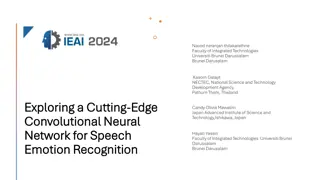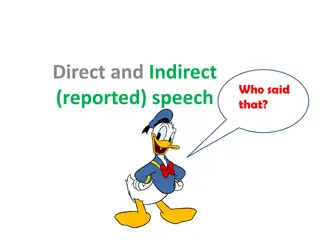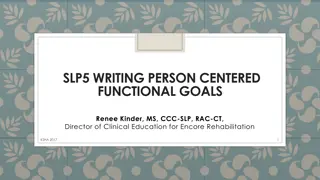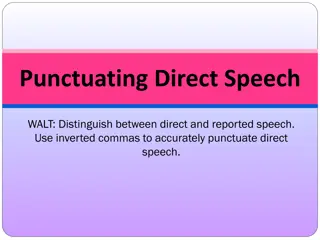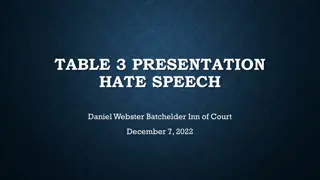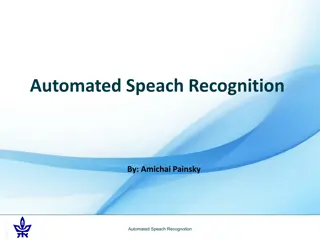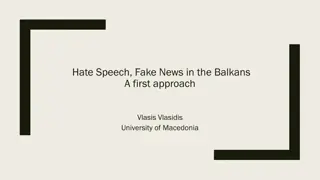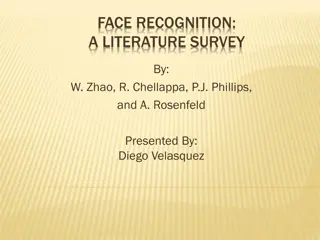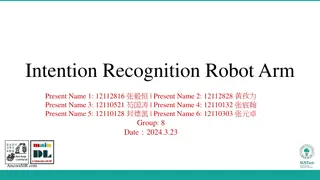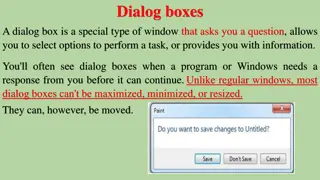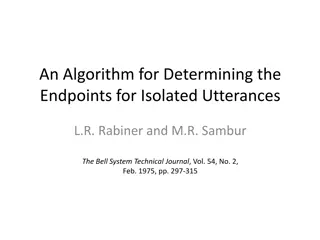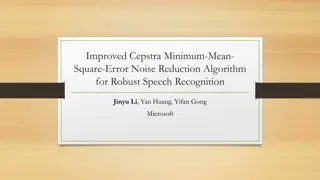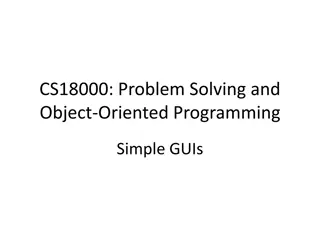Speech Recognition and Dialog Systems
Acoustic analysis, word recognition models such as HMM, linguistic analysis with syntactic and semantic interpretation, and the significance of prosody in ASR systems are explored in this informative content. The structural elements and processes involved in speech recognition and dialog systems are detailed, shedding light on the underlying technologies and methodologies utilized.
Download Presentation

Please find below an Image/Link to download the presentation.
The content on the website is provided AS IS for your information and personal use only. It may not be sold, licensed, or shared on other websites without obtaining consent from the author.If you encounter any issues during the download, it is possible that the publisher has removed the file from their server.
You are allowed to download the files provided on this website for personal or commercial use, subject to the condition that they are used lawfully. All files are the property of their respective owners.
The content on the website is provided AS IS for your information and personal use only. It may not be sold, licensed, or shared on other websites without obtaining consent from the author.
E N D
Presentation Transcript
FLST: Speech Recognition Bernd M bius moebius@coli.uni-saarland.de http://www.coli.uni-saarland.de/courses/FLST/2014/ FLST: Speech Recognition
ASR and ASU Automatic speech recognition recognition of words or word sequences necessary basis for speech understanding and dialog systems Automatic speech understanding more directly connected with higher linguistic levels, such as syntax, semantics, and pragmatics 2 FLST: Speech Recognition
Structure of dialog systems ASR NLG speech synthesis feature extraction word recognition answer generation dialog control syntactic analysis pragmatic analysis semantic analysis ASU 3 FLST: Speech Recognition
Acoustic analysis 0.1494 Feature extraction utterance is analyzed as a sequence of 10 ms frames in each frame, spectral information is coded as a feature vector (MFCC, here: 12 coefficients) MFCC = mel frequency cepstral coefficients typically 13 static and 26 dynamic features 0 -0.3043 0.07922 0.1391 Time (s) 12 Coefficients 0.07922 1 0.1391 Time (s) 4 FLST: Speech Recognition
Acoustic analysis Word recognition acoustic model (HMM): probabilities of sequences of feature vectors, given a sequence of words stochastic language model: probabilities of word sequences n-best word sequences (word hypotheses graphs) 5 FLST: Speech Recognition
Word hypotheses graph [Kompe 1997] 6 FLST: Speech Recognition
Linguistic analysis Syntactic analysis finds optimal word sequence(s) w.r.t. word recognition scores and syntactic rules / constraints determine phrase structure in word sequence relies on grammar rules and syntactic parsing Semantic analysis utterance interpretation (w/o context/domain info) Pragmatic analysis disambiguation and anaphora resolution (context info) 7 FLST: Speech Recognition
Relevance of prosody Output of a standard ASR system: WHG sequences of words without punctuation and prosody ja zur not geht's auch am samstag Alternative realizations with prosody (1) Ja, zur Not geht's auch am Samstag. 'Yes, if necessary it will also be possible on Saturday.' (2) Ja, zur Not. Geht's auch am Samstag? 'Yes, if absolutely necessary. Will it also be possible on Sat?' (3) - (12) not only in contrived examples! 8 FLST: Speech Recognition
Relevance of prosody Prosodic structure sentence mode: Treffen wir uns bei Ihnen? 'Do we meet at your place?' Treffen wir uns bei Ihnen! 'Let's meet at your place!' phrase boundaries: F nfter geht bei mir, nicht aber neunzehnter. 'The fifth is possible for me, but not the nineteenth.' F nfter geht bei mir nicht, aber neunzehnter. 'The fifth is not possible for me, but the nineteenth is.' accents: Ich fahre doch nach Hamburg. 'I will go to H (as you know).' Ich fahre DOCH nach Hamburg. 'I will go to H after all.' 9 FLST: Speech Recognition
Prosody in ASR Historical perspective application domains for ASR until mid/late 1990s: information retrieval dialog since then also: less restricted domains, free dialog a chance to demonstrate the impact of prosody! dialog turn segmentation information structure user state and affect first end-to-end dialog system using prosody: Verbmobil 10 FLST: Speech Recognition
Role model systems: Verbmobil Architecture multilingual prosody module: German, English, Japanese common algorithms, shared features, separate data input: speech signal, word hypotheses graph (WHG) output: prosodically annotated WHG (prosody by word), feeding other dialog system components (incl. MT): detected boundaries dialog act segmentation, dialog manager, deep syntactic analysis detected phrase accents semantic module detected questions semantic module, dialog manager 11 FLST: Speech Recognition
Role model systems: SmartKom Beyond Verbmobil: (emotional) user state architecture: input and output as in Verbmobil prosodic events: accents, boundaries, rising BTs user state as a 7-/4-/2-class problem: joyful (s/w), surprised, neutral, hesitant, angry (w/s) joyful, neutral, hesitant, angry angry vs. not angry realistic user states evoked in WOZ experiments large feature vector: 121 features (91 pros. + 30 POS), different subsets for events and user state 12 FLST: Speech Recognition
SmartKom Classification performance (% correct recog.) train test prominent words 81.0 77.0 88.6 phrase boundaries 89.8 rising BT 72.0 66.4 user state (7) *30.8 * leave one out **68.3 user state (4) ** multimodal *66.8 user state (2) prosodic events (emotional) user state [Zeisssler at al. 2006] 13 FLST: Speech Recognition
Role model systems: SRI Acoustic feature space of prosodic events similar to VM/SK approach: features derived from F0 contour, duration (phones, pauses, rate), energy feature extraction by proprietary toolkit, but claimed to be feasible with standard software (Praat, Snack) standard statistical classifiers all models are probabilistic and trainable to tasks integration of prosodic and lexical modeling language-independent: English, Mandarin, Arabic [www.speech.sri.com/people/ees/prosody] 14 FLST: Speech Recognition
Parameters and functions Analysis problem: many-to many mapping of parameters to functions F0 duration intensity spectral prop. lexical tone lexical stress, word accent syllabic stress accenting prosodic phrasing sentence mode information structure discourse structure speaking rate pauses rhythm voice quality phonation type 15 FLST: Speech Recognition
Prosody recognition Some approaches to exploiting prosody for ASR recognition of ToBI events [Ostendorf & Ross 1997, ToBI-Lite: Wightman et al. 2000] resolving syntactic ambiguities using phrase breaks [Hunt 1997] analysis-by-synthesis detection of Fujisaki model parameters [Hirose 1997; Nakai et al. 1997] detection of phrase boundaries, sentence mode, and accents [Verbmobil: Hess et al. 1997] detection of prosodic events to support dialog manager [Verbmobil, SmartKom: Batliner & N th et al. 2000-2003] 16 FLST: Speech Recognition
Conclusion Prosody is an integral part of natural speech processed and used extensively by human listeners Few ASR/ASU systems exploit prosodic structure Prosody can play an important role in ASR prosodic features are potentially useful on all levels of ASR/ASU systems, including affective user state 17 FLST: Speech Recognition
Human-machine dialog 18 FLST: Speech Recognition
Thanks! 19 FLST: Speech Recognition
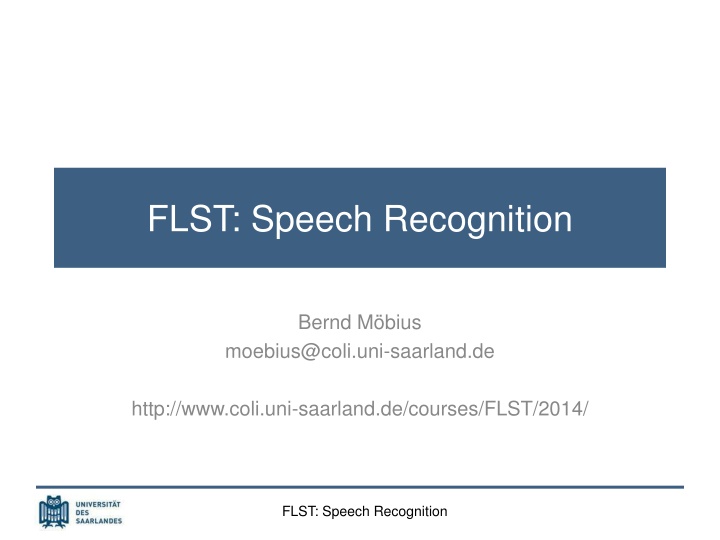

![Prevention and Combating of Hate Crimes and Hate Speech Bill [B.9B.2018]](/thumb/60513/prevention-and-combating-of-hate-crimes-and-hate-speech-bill-b-9b-2018.jpg)

